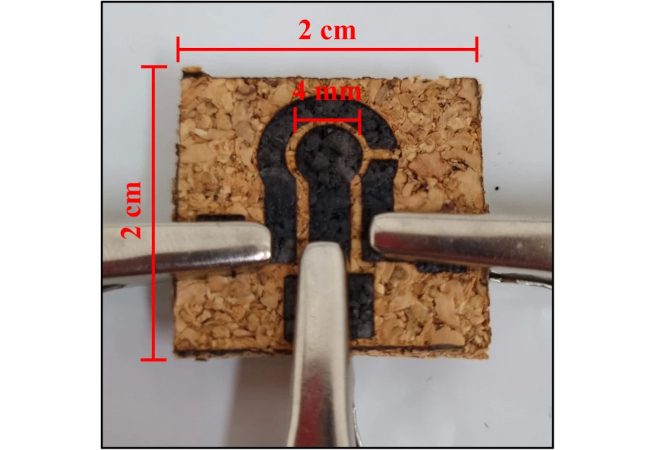

The project is currently undergoing laboratory validation and design refinement (image: Beatriz Germinare et al./Microchimica Acta)
Sodium nitrate is used as a preservative and to add color to products such as ham and sausages, but is potentially carcinogenic and cannot be applied in beverages; researchers at the Federal University of São Carlos used pieces of cork and lasers to develop a sensor.
Sodium nitrate is used as a preservative and to add color to products such as ham and sausages, but is potentially carcinogenic and cannot be applied in beverages; researchers at the Federal University of São Carlos used pieces of cork and lasers to develop a sensor.

The project is currently undergoing laboratory validation and design refinement (image: Beatriz Germinare et al./Microchimica Acta)
By Thais Szegö | Agência FAPESP – A team of researchers from the Federal University of São Carlos (UFSCar) in the state of São Paulo, Brazil, has developed a sensor that can identify sodium nitrite (NaNO2) in various beverages, including mineral water, orange juice, and wine. This inorganic salt is used as a preservative and fixative to give products such as ham, bacon, and sausages their pink or red color. Depending on the amount, it can cause serious health problems by leading to the formation of nitrosamines, which are carcinogenic compounds.
“This risk motivated us to develop a simple, fast, and accessible way to detect the compound and ensure the quality and safety of liquid consumption,” says Bruno Campos Janegitz, head of the Laboratory of Sensors, Nanomedicine, and Nanostructured Materials (LSNano) at UFSCar. Janegitz coordinated the study, which was published in the journal Microchimica Acta. “Detection [of NaNO2] in beverages, especially wines, is important for quality control, since its use is not legally permitted in Brazil and most countries,” the authors write in the article.
According to the researcher, LSNano projects aim to use materials from low-cost platforms that generate added value while respecting the environment. In this case, cork was chosen as the starting point because it is lightweight, natural, and inexpensive.
The samples were laser-marked to transform them into graphene, a highly conductive form of carbon, as if concentrated light had drawn paths in the cork. “This process is sustainable, doesn’t require toxic reagents, and results in a highly conductive material, which is essential because nitrite undergoes well-known electrochemical oxidation. Therefore, we need a highly conductive sensor to detect the compound,” Janegitz explains.
Next, a waterproof spray was applied to the cork to prevent any liquid from seeping into the material and compromising the sensor’s response. Then, a layer of nail polish was applied to delimit the modified area. The samples were then placed in an oven at 40 °C for 30 minutes to dry and optimize the laser parameters.
The next step in the project, supported by FAPESP (23/14943-6, 23/00317-6 and 23/06793-4), was to place samples of water, orange juice, and wine diluted in an electrolyte solution with salts simulating nitrite on the graphene.
The results showed that the sensor performed excellently, with high sensitivity and good stability. It was able to detect nitrite at concentrations compatible with those relevant to food and environmental safety.
The project is still in the laboratory validation phase, and improvements to the design are needed for practical use.
“This study was only possible thanks to the collective effort of several students in our research group who had or have FAPESP scholarships. The first author of the paper is master’s student Beatriz Germinare, who conducted her research with a FAPESP scientific initiation scholarship.”
The article “Cork-based electrochemical sensors obtained by laser-induced graphene: A green alternative for sodium nitrite detection in beverage samples” can be read at link.springer.com/article/10.1007/s00604-025-07471-9.
Republish
The Agency FAPESP licenses news via Creative Commons (CC-BY-NC-ND) so that they can be republished free of charge and in a simple way by other digital or printed vehicles. Agência FAPESP must be credited as the source of the content being republished and the name of the reporter (if any) must be attributed. Using the HMTL button below allows compliance with these rules, detailed in Digital Republishing Policy FAPESP.





